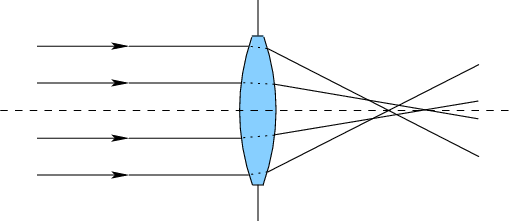
Next: Optical distortion Up: 4.3 Optical Aberrations Previous: Chromatic aberration Contents Index
 |
Figure 4.19 shows spherical aberration, which is caused by rays further away from the lens center being refracted more than rays near the center. The result is similar to that of chromatic aberration, but this phenomenon is a monochromatic aberration because it is independent of the light wavelength. Incoming parallel rays are focused at varying depths, rather then being concentrated at a single point. The result is some blur that cannot be compensated for by moving the object, lens, or image plane. Alternatively, the image might instead focus onto a curved surface, called the Petzval surface, rather then the image plane. This aberration arises due to the spherical shape of the lens. An aspheric lens is more complex and has non-spherical surfaces that are designed to specifically eliminate the spherical aberration and reduce other aberrations.
Steven M LaValle 2020-11-11